How to address without an address? Identify locations quickly and easily with what3words or Plus Code or rather Open Location Code.

More than 2 billion people all over the world don’t have any address
"Down the road, third right, and then turn left before the woods." There are several ways to tell someone a location. The one above is not quite the smartest. But what to do if there is no classical address with street name, house number and postal code at all? What are the options, when my site is located in the postal nowhere?
In fact, this is the case for Elano – one of more than 2 billion people in the world without an address. He lives in Brazil's largest favela, Rocinha, in Rio de Janeiro. In the maze of nooks, crannies and tunnels, the alleys rarely have street names, or even worse: many different names for one and the same exist.
For example, the registration address may be Rua 5 (Street 5), the electricity provider lists it as Rua 10, the inhabitants themselves call the street Morro da Roupa Suja (Hill of Dirty Clothes). House numbers - if they exist - do not follow a uniform logic. They are assigned geographically here, chronologically there, or completely random, and even within a street they are assigned three times. Many houses have been built illegally and officially do not exist. Delivering mail in this labyrinth is a real challenge. Elano has never received a letter in his life.
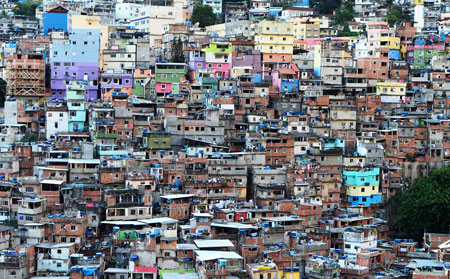
With geocoordinates, any place in the world can be precisely determined
In any case without an address, WGS84 geocoordinates provide a remedy. WGS84 stands for World Geodetic System 1984. That is a geodetic reference system as a uniform basis for position information on earth. It is the basis of GPS and is now available in every smartphone. These geocoordinates bring places like favelas, townships and reservations out of the postal nowhere. But they are also very helpful for construction sites, new construction areas or allotment sites without a classic address.
With the degree of longitude and latitude, which are further subdivided into minutes and seconds, any place in the world can be precisely determined. The different notations of the coordinates do not necessarily make the input easier - at least for humans. As an example, here is the position of an intersection South Craig Street / Winthrop Street in Pittsburgh, USA:

In daily life geo-coordinates are often not suitable because of the several options of notation
At the same time, this variety of possible notations reveals a major practical obstacle in dealing with WGS84 coordinate data: It is excellently suited to automatically transmit position information between systems, provided that the appropriate format is agreed upon beforehand during system coupling. Whereas in daily life they are unsuitable when humans are involved in the transmission. Besides the challenge of different formats, it is really exhausting to type in the long columns of numbers. According to that, errors often creep in. For example, a cab driver or parcel carrier ends up in the middle of nowhere in Pennsylvania instead in the planned area in Pittsburg, what results on the mistake of the entered numbers.
With that in mind, various ideas have emerged to simplify position determination. For instance for bicycle delivery services that can still reliably deliver pizza to hungry customers in the park, even when no “classic” addresses exist. Another example could be a construction company that is approaching a construction site right away, without having to master long columns of numbers.
The idea was to create a "vehicle" similar to a zip code, but without the typical restrictions. For example, there should be no structural differences in codes from country to country, allow much finer positioning, and work even where mail has never been delivered. These considerations gave rise to several different new geocoding systems on the market, such as 3GeoNames (3D), Xaddress, GeohashPhrase, Geotude/Posttude, GeoHash, MapCode, and Open PostCode. Those systems all have the common disadvantage, that they have not been able to establish themselves comprehensively on the market. Only the market leaders what3words and Google's Open location code / Plus Code have managed to do this with significant market share. Both offer a simple system to name, share and find places with pinpoint accuracy. Each of those systems has different advantages and disadvantages. Because of this we will give you a short overview in the following.
Three-word address /// banden.aufhielt.fragt – what3words
The concept of what3words is simple: the world is divided into 3 x 3 meter squares and each square is assigned a unique combination of three words. They completely replace the classic address. For our Uniserv building at Rastatter Straße 13 in Pforzheim, for example, the three-word address is ///banden.aufhielt.fragt. If you look for our front door, you get ///anführer.bisher.bedurfte, our driveway is given the location ///einziehen.loben.aktuellen.
These examples show that the terms were selected randomly from its database by a proprietary algorithm. They have no linguistic semantic meaning, but are easy to remember - often precisely just because of the curious combinations. The system is language-dependent; each of the 45 stored languages has its own word list, each of the word lists contains around 25,000 words. For example, the answer to the question "where should we deliver the pizza?" with what3words is no longer "in Volkspark Friedrichshain pretty much in the middle, under the big tree, close to the pond," but precisely ///ehrenvolle.wüste.fixstern.

This question is also answered reliably by Google's Plus Code. However, here the answer is different, namely: GCHM+57 Berlin.
8FWCVMX8+5V - Google Plus Code
Google's Plus Code (also called Open Location Code or OLC for short) converts the long column of numbers consisting of latitude and longitude into a shorter, much simpler code consisting of letters and numbers. After the eighth digit there is always a plus sign, among other things to distinguish it from a postal code - this also explains where the designation Plus Code comes from.
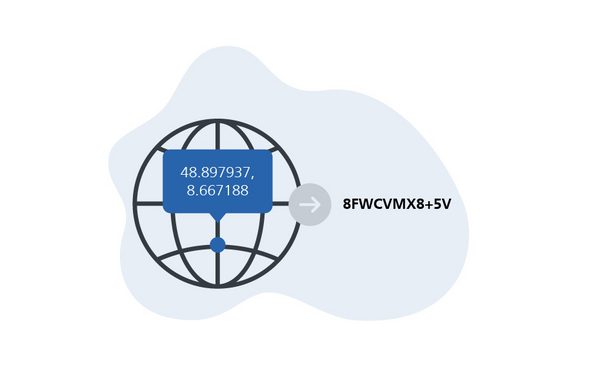
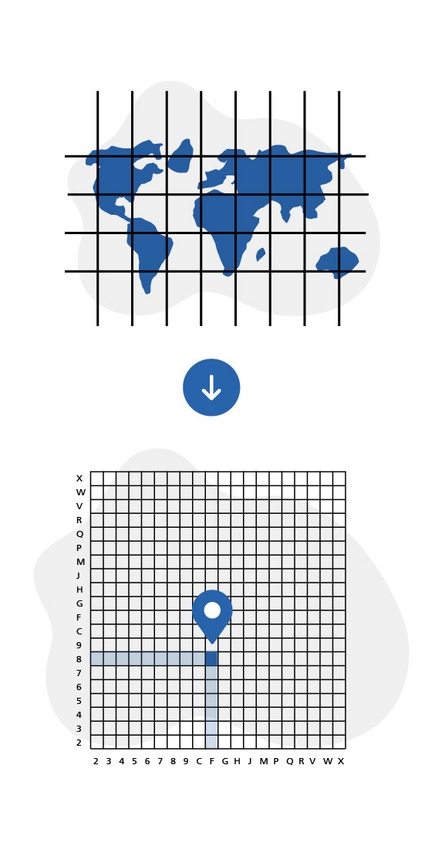
Illustrations based on Plus Codes Technology
The algorithm divides the earth's surface into a grid like a quad-tree tile. The first four digits of the code identify a cell from an 18 x 9 grid covering the earth. Subsequent steps divide this area into a 20 x 20 grid and use one character to identify the row and another to identify the column. From the 10th character on, the refinement is done with a subdivision of a 4 x 5 grid, where each grid cell is identified by a single character.
The first four digits indicate a region of about 111 x 111 kilometers at the equator. The following characters indicate the exact area within this region. Depending on how precise the position description is to be, another letter can be appended at the end. This gives a grid about the size of 14 x 14 meters with 10 alphanumeric characters and about 3 x 3 meters with 11 characters, which is often more accurate than a house number.
8FWCVMX8+5VH, for example, describes the location of the Uniserv building in Pforzheim with a precision of 3 x 3 meters. It is also possible to specify the position with 8FWCVMX8+5V (precision 14 x14 meters). So here we don't work with words as with what3Words, but with a 10-or11-digit letter and number code.
Same in this context, the Plus Code replaces the "classic" postal address consisting of district, street, house number and postal code. It is much faster and can be entered error-free even without considering national or local peculiarities and ambiguities.
If the location is within or close to a clearly identified city, the Area Code is not necessarily needed. Instead, the Local Code can be used together with the name of the city. VMX8+5V Pforzheim also describes the position of the Uniserv building.
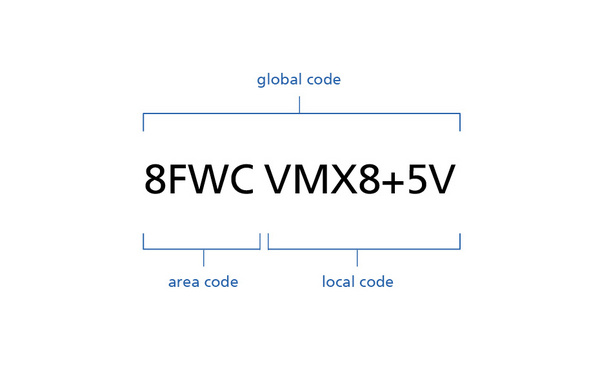
What3words and Plus Code in practical use
Both what3words and Plus Code bring a number of practical advantages for many use cases. With these options, the challenges and peculiarities of classic addresses are completely eliminated.
Elano and the residents of Rocinha can now store online and have packages sent to their addresses thanks to what3words - previously unimaginable. A local initiative, Carteiro Amigo (friendly Postman), offers residents three-word addresses, which they can then deliver to.
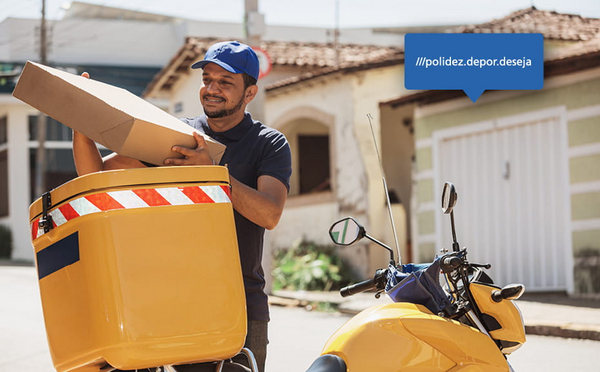
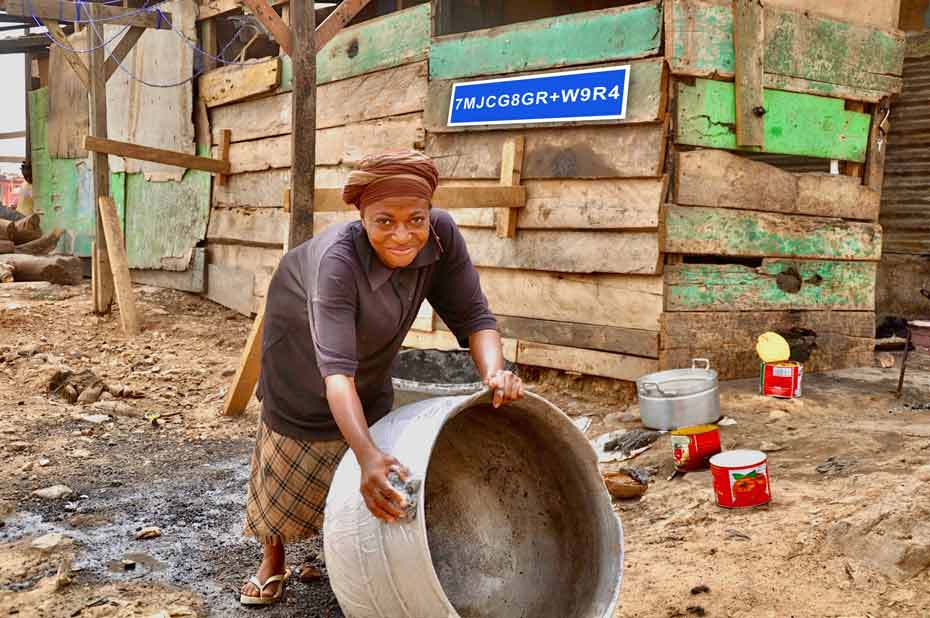
Another example comes from India. Here, the nonprofit organization Addressing the Unaddressed (ATU) helped people in the "unplanned" settlements of Calcutta get addresses. ATU staff walked through the slums and assigned a plus code to each apartment via a smartphone app. Since the average apartment size here is extremely small, it was important that the addresses are very precise. Therefore, the decision was made here to use a 12-digit Plus Code which allows for a precision of approximately 60 x 90 centimeters. The residents were getting an address-board which was placed above or next to the doors.
Not only residents in underdeveloped countries benefit from the new geocodes, though. From parcel couriers to ambulance drivers to cab drivers, everyone involved in delivery and transport chains can save themselves the hassle of searching for entrances, transfer points or drop-off locations. Because even when a unique address is available, some locations often cannot be described precisely enough. Large hospitals with several entrances or factory premises with many gates often invite to wandering around.
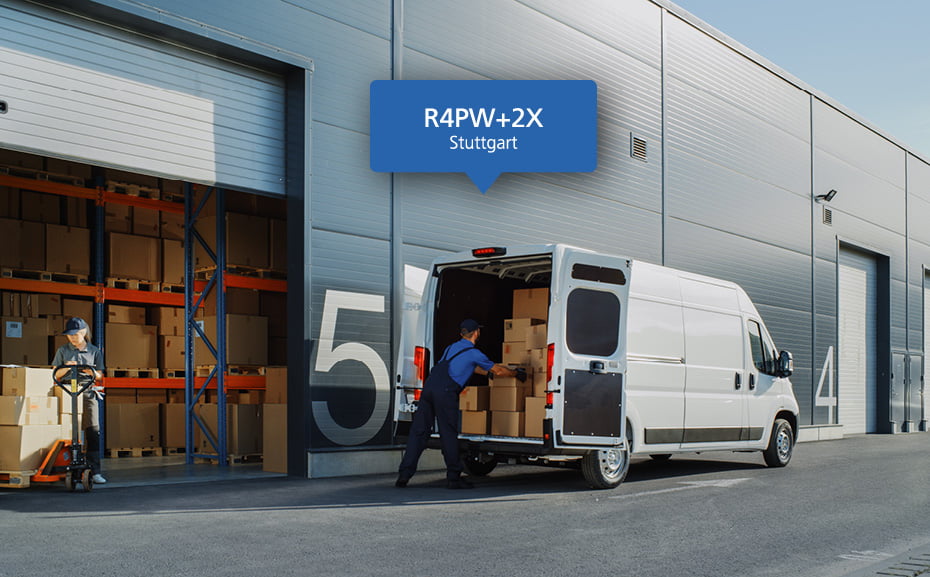
Important additional information, such as entrance or filing location, can then be added to an address in the form of the geocodes. Companies that rely on efficient address localization can thus benefit from geocoding systems in many industries. For example, shareholder Mercedes-Benz has incorporated what3words into the navigation systems of vans and equipped parts of the DPD fleet with them.
The significantly simplified handling - both on the data entry side and in the actual target achievement on site - ensures a lower error rate and thus clear time and cost reductions. Conversely, the globally unique codes make it easier and therefore more efficient to locate companies, people, delivery or drop-off points. And this can save lives in the event of a rescue or disaster, for example.
Choice of the appropriate geocode
When selecting the appropriate geocode, the most important question is about the specific use case: Is the input to be made via a form or by voice? Are positions to be determined regionally or nationally, or is it a cross-border use case that requires the greatest possible independence from language and written culture? Is it important that the geocode works "out of the box" with Google Maps? If these and a number of similar questions are considered when choosing the appropriate geocode, companies can make their localization processes more independent and future-proof.
Direct comparison of the what3words and Plus Code systems
Basically, both systems convince with a simplified and clearly structured setup of the geocodes. What3words is easier to remember. On the other hand, the Plus Code is at advantage because of its easier cross-border use, since it is not tied to country-specific languages. It is even completely independent of local idioms and characters. In addition, the codes of what3words are generally longer due to their structure and are less suited for entry in form fields or as information in an e-mail. The voice input, if also with a certain risk of errors, is again an advantage of what3words.
Summary
WHAT3WORDS | PLUS CODE | |
|---|---|---|
| ///banden.aufhielt.fragt | 8FWCVMX8+5V or VMX8+5V Pforzheim |
| Advantages |
|
|
| Special Characteristics | Representing a geographical position with three colloquial words has something fascinating/magical for many users. | Google Maps supports the Plus Code and is known or already installed by many end users. In Google Maps, the Plus Code is displayed by default in the location search and can be identified. |
This is only a highly compacted summary. The Uniserv geocoding experts have carried out an extensive detailed evaluation of the individual features. If you are interested in this topic, please contact our team.
Optimization of the addressing
When it comes to reaching customers and prospects not only electronically but also physically, correct and easy-to-use addressing is a key factor even in the age of digitalization. Besides the "classic" postal address and, if applicable, WGS84 coordinates, the "new" geocodes presented here expand the possibilities of addressing and thus, in many cases, make the business model more customer-friendly. This is because they complement the scope, performance, and utility of the previous systems. On the one hand, the corresponding geocodes can be send out in parallel for a classic address. On the other hand, localization can be continued where a postal address with the classic elements no longer applies. Be it at Elano’s home in Rio or the delivery of building materials to a new construction area in Pforzheim, where no signs for street names and house numbers exist.
Would you like to discuss your specific use case in comparison of the different geolocalization systems? Do you want to dive deeper into the topic of geocoding? Schedule a 45-minute video call with one of our geocoding experts.